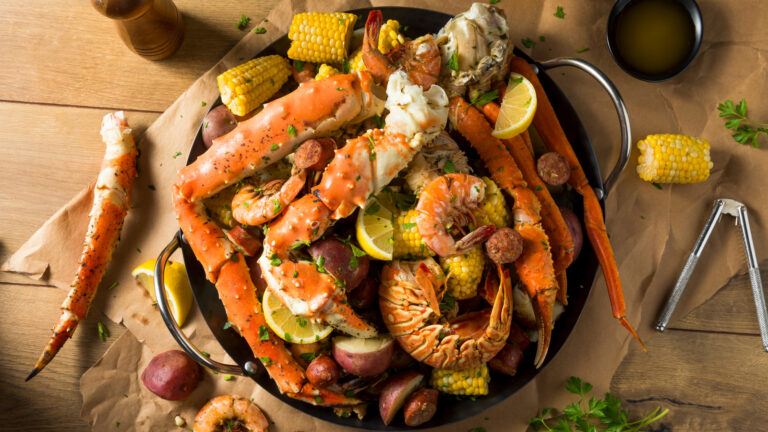Seafood boil is a popular dish in many coastal regions across the world. It typically consists of a mix of seafood such as shrimp, crab, crawfish, mussels, and clams, along with vegetables such as corn on the cob, potatoes, and onions.
The seafood and vegetables are boiled together in a large pot with spices and seasonings, which infuses the dish with a flavorful and aromatic taste. Get ready to indulge in a mouthwatering seafood boil that’s best enjoyed with family-style dining. Gather your loved ones around the table and dive into a scrumptious feast that’s sure to leave everyone satisfied.
Common Ingredients Used in Seafood Boil
When it comes to seafood boils, there are a variety of ingredients commonly used to create a delicious and flavorful dish. The most popular ingredients include crab, shrimp, clams, mussels, corn on the cob, potatoes, and sausage.
Other common additions may include garlic, onions, celery, and spices, such as Old Bay seasoning. Of course, the specific ingredients used can vary depending on personal preference and regional variations.
No matter what ingredients, a seafood boil is an irresistible crowd-pleaser! Its mouth-watering aroma, taste, and vibrant colors make it an absolute must-have for any gathering. Whether it’s a family get-together, a backyard barbecue, or a beach party, seafood boil is the star that leaves your guests craving more.
Read Also:
How to Store Leftover Seafood Boil
If you have leftover seafood boil, it’s important to store it properly to ensure that it stays fresh and safe to eat. Here are some tips for storing leftover seafood boil:
- Remove the seafood and vegetables from the broth and store them separately in airtight containers in the refrigerator.
- Store the broth separately in an airtight container in the refrigerator. The broth can be used to make a delicious seafood soup or chowder.
- Leftover seafood boil can be stored in the refrigerator for up to 3 days.
- Are you looking to preserve the freshness of your boiled seafood for a longer duration? Simply store the seafood and vegetables in airtight containers and freeze for up to 3 months.
Methods to Reheat Seafood Boil
Are you looking for ways to relish your leftover seafood boil? No worries! There are efficient approaches available for you to try, depending on your preference and the equipment you have available. Here are three popular methods:
1. Reheating Seafood Boil in the Oven:
2. Reheating Seafood Boil on the Stove:
3. Reheating Seafood Boil in the Microwave:
Reheating Seafood Boil in the Oven
Reheating seafood boil in the oven is a great way to enjoy leftovers without sacrificing flavor. To do so, preheat your oven to 350°F (175°C). Place the seafood boil in an oven-safe dish and cover it with aluminum foil. Heat it in the oven for about 15 minutes or until it reaches the desired temperature.
Make sure to check the internal temperature of the seafood boil with a food thermometer to ensure it is heated to at least 165°F (74°C) to prevent any foodborne illnesses. Enjoy your reheated seafood boil!
Reheating Seafood Boil on the Stove
To reheat seafood on the stove, you can fill a large pot with enough water to submerge the seafood and bring it to a boil. Once the water is boiling, add the seafood to the pot and let it cook for about 5 minutes. Be sure to stir occasionally to ensure even heating.
Once it’s heated through, use a slotted spoon to remove the seafood from the pot and serve immediately. Enjoy!
Reheating Seafood Boil in the Microwave
To reheat seafood boil in the microwave, place the seafood and vegetables in a microwave-safe dish and add a small amount of water or broth. Cover the dish with microwave-safe plastic wrap or a lid and microwave on high for 1-2 minutes or until heated through.
It’s important to note that reheating seafood boil can cause the seafood to become tough or rubbery, so it’s best to reheat it gently and not overcook it.
It’s important to check for any signs of spoilage or odor in the seafood or vegetables before reheating. Discard any items that seem to be spoiled or past their expiration date to prevent health hazards.
Tips to Keep in Mind When Reheating Seafood Boil
When reheating seafood, it’s important to keep a few things in mind to ensure that the food is safe to eat and still tastes good. First, make sure that you refrigerate any leftovers promptly after the meal is over.
When you’re ready to reheat the seafood boil, use a steamer basket or a large pot of boiling water to heat the food until it’s hot. Avoid microwaving the seafood boil, as this can cause the food to become mushy and lose its texture. Finally, discard any leftovers sitting at room temperature for more than two hours.
With these tips, you can savor your seafood boil once more with complete peace of mind! Don’t let any worries hold you back from enjoying every bite – follow these recommendations and dive in!
Serving Suggestions for Reheated Seafood Boil
When it comes to serving reheated seafood boil, there are various ways to enjoy this delicious dish. Here are some serving suggestions to consider:
- Serve with crusty bread: Seafood boil goes well with a slice of crusty bread, which you can use to soak up the flavorful broth.
- Add fresh herbs: Sprinkle some fresh herbs like parsley, cilantro, or dill on top of the seafood boil to give it an extra burst of flavor.
- Add a side salad: Pair your seafood boil with a side salad to balance out the richness of the dish.
- Make a sandwich: Use the leftover seafood and vegetables to make a sandwich with some crusty bread and your favorite condiments.
- Serve with rice or pasta: Seafood boil can also be served with rice or pasta to make a heartier meal.
No matter how you serve it, reheated seafood boil is a delicious and satisfying dish for any occasion.
Conclusion
Reheating seafood boil can be a great way to enjoy leftovers without sacrificing flavor. Whether you choose to reheat it in the oven, on the stove, or in the microwave, it’s important to do so gently to prevent the seafood from becoming tough or rubbery.
However, the following the methods and tips outlined in this article, you can ensure that your leftover seafood boil stays fresh, safe to eat, and delicious for as long as possible.



